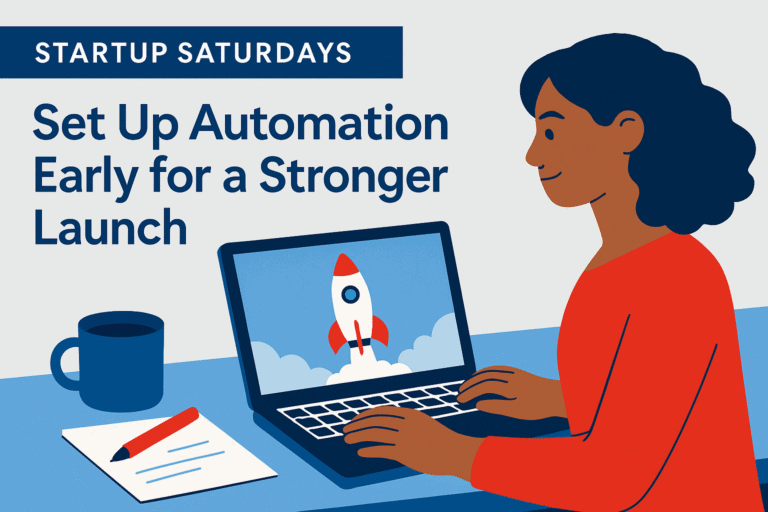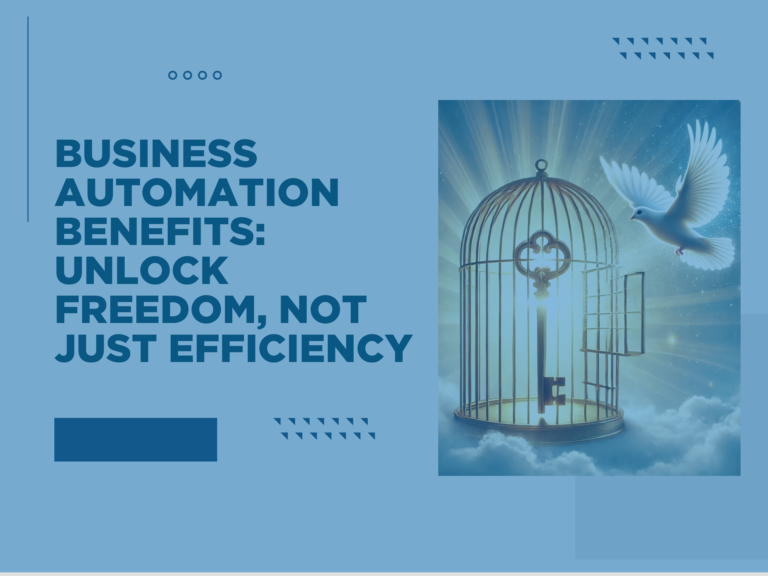Startup Saturdays
When you’re starting a business while still working a job, the resource you’ll feel most squeezed on isn’t money—it’s time. You already know the juggling act: work deadlines, family obligations, errands, and then somewhere in the margins, the business you want to grow. That’s why startup time saving strategies aren’t optional. They’re the only way to move your business forward without burning out.
When I revived Backbone America, I wasn’t doing it from a place of desperation like my first attempt back in 2016. This time I had a stable job covering my bills, which gave me the freedom to think differently. I didn’t need my business to save me. I needed it to fit me. And that shift in mindset is what made time such a precious currency.
Every hour I could claim for my business was worth more than dollars in the bank because those hours compounded. The time I invested into building repeatable systems, automation, and clear offers paid me back with freedom later. That’s what I want for you too.
So let’s talk about five startup time saving strategies that will help you launch faster without losing sight of why you started in the first place.
1. Validate First, Build Later

One of the fastest ways new entrepreneurs lose time is by building too much, too soon. Entire websites, course libraries, or product lines are created before anyone proves there’s demand. And then the founder is left exhausted, with nothing to show for it but sunk hours.
Why this matters: Validation ensures that the hours you invest are spent on something people actually want. It’s about testing the smallest version of your idea before you spend months or years scaling it up.
How it works in real life: When I came back to Backbone America, I didn’t start by creating a dozen new courses. I put out one: the 31-Day Business Startup Challenge. That single product let me test whether my approach—helping mid-career professionals launch a business in structured, bite-sized steps—was resonating. The feedback gave me confidence to expand without second-guessing.
How you can apply it now: Before you spend nights and weekends building the “perfect” version of your business, test your idea. This could be as simple as offering a paid workshop, setting up a landing page to capture interest, or selling a beta version to a small group. The key is speed—get it in front of real people, see if they buy, and refine from there.
2. Use Templates and Systems Early
You don’t have to reinvent every email, contract, or workflow. That mindset leads to wasted hours, often on tasks that don’t directly bring in revenue.
Why this matters: Templates reduce decision fatigue. Systems reduce mistakes. Together, they give you time back that can be reinvested in the work only you can do—like serving clients or building offers.
How it works in real life: In my role as a Business Process Automation Engineer, I’ve seen how organizations collapse under the weight of manual processes. That lesson carried over to my business. I created templates for proposals, client intake, and even my own blog outlines. Instead of starting from scratch each week, I had a system that cut my writing time in half.
How you can apply it now: Start small. Choose one area where you repeat yourself often—emails, social posts, onboarding steps—and create a reusable template. Keep refining it until it saves you at least 15 minutes each time. Over a year, those minutes add up to entire workdays saved.
3. Automate the Simple Stuff
When people hear “automation,” they think complex systems. But in reality, some of the most powerful startup time saving strategies come from automating the simplest, most repetitive tasks.
 Why this matters: You don’t need to be a tech wizard to reclaim hours with automation. Even one automated follow-up email or calendar integration can free your mind from constant checking and reminding.
Why this matters: You don’t need to be a tech wizard to reclaim hours with automation. Even one automated follow-up email or calendar integration can free your mind from constant checking and reminding.
How it works in real life: When I relaunched Backbone America, I automated my lead capture and email delivery. Someone signs up for a guide, and the system delivers it instantly—without me lifting a finger. That one step meant I didn’t have to watch my inbox or manually send links. The system did it, perfectly, every time.
How you can apply it now: Look at your day-to-day routines. Do you confirm every meeting by hand? Do you send the same welcome email a dozen times? Start with tools like Zoho Flow, Zapier, or even built-in CRM automations. The goal isn’t to replace you—it’s to remove the tasks that don’t need your personal touch.
4. Set Clear Boundaries with Work + Life
It’s one thing to have strategies on paper. It’s another to protect the hours that make those strategies real. Boundaries are the bridge between wanting more time and actually creating it.
Why this matters: Without boundaries, your business becomes the thing you “try to get to.” With them, your business has protected time to grow. Even two focused hours a week are worth far more than scattered minutes stolen between tasks.
How it works in real life: I’ll admit—this was tough for me. My job, my family, and my own fatigue all competed for my attention. What made the difference was scheduling business hours like I would a meeting. If I blocked off time in the mornings. That time was sacred. It wasn’t “maybe.” It was happening.
How you can apply it now: Take an honest look at your calendar. Where can you block 2–3 hours weekly for your business? Treat it as non-negotiable. Protect it from work creep, social obligations, or endless errands. It might not feel like much at first, but consistent blocks compound into momentum.
5. Leverage Your Existing Resources
 When you’re launching a business, it’s tempting to believe you need to start from scratch. But that mindset overlooks the resources you already have—skills, networks, tools, even your paycheck.
When you’re launching a business, it’s tempting to believe you need to start from scratch. But that mindset overlooks the resources you already have—skills, networks, tools, even your paycheck.
Why this matters: Leveraging existing resources saves time by removing unnecessary learning curves or financial strain. Instead of hustling to reinvent, you build on what’s already working for you.
How it works in real life: My day job wasn’t just a paycheck. It was my investor. By keeping my bills covered, it gave me the freedom to reinvest profits back into Backbone America. My tech background became another resource—I could design my own systems without waiting on a developer. These weren’t shortcuts; they were accelerators.
How you can apply it now: Make a list of what you already have. Do you know a designer who could help polish your first sales page? Do you already pay for software at work that has transferable skills? Is your paycheck stable enough to cover early business costs? Use what you have before spending extra time or money chasing what you don’t.
How I Applied These Strategies
Every one of these startup time saving strategies shaped the way I rebuilt Backbone America. Validation helped me avoid wasting time on offers nobody wanted. Templates made my weekly content creation sustainable. Automation kept my lead flow alive without my constant attention. Boundaries ensured I had consistent time to work, even when life was busy. And leveraging resources meant I didn’t need to gamble my stability to grow.
The difference this time wasn’t just strategy—it was alignment. My business fit my life, not the other way around. And that’s why it stuck.
Building a Business That Fits Your Life

What matters is that your business becomes a path to freedom—not another job.
If you’re looking for a practical way to start, my Work Less, Build Smart system walks you through step-by-step actions to launch without wasting time on the wrong things.
Final Thoughts
Your most valuable startup resource isn’t money. It’s time. Every hour you put into your business should move you closer to freedom, not deeper into exhaustion.
The five startup time saving strategies I’ve shared here aren’t magic—they’re practical. They’re the same ones that helped me rebuild Backbone America in a way that actually fit my life. And they’re the ones that can help you launch faster without sacrificing everything else that matters.
If you want more strategies like these—tools, frameworks, and honest insights you won’t find anywhere else—sign up for my mailing list. You won’t just get updates. You’ll get transformative guidance to help you design a business that frees your time instead of consuming it. Join here to stay in the know.






